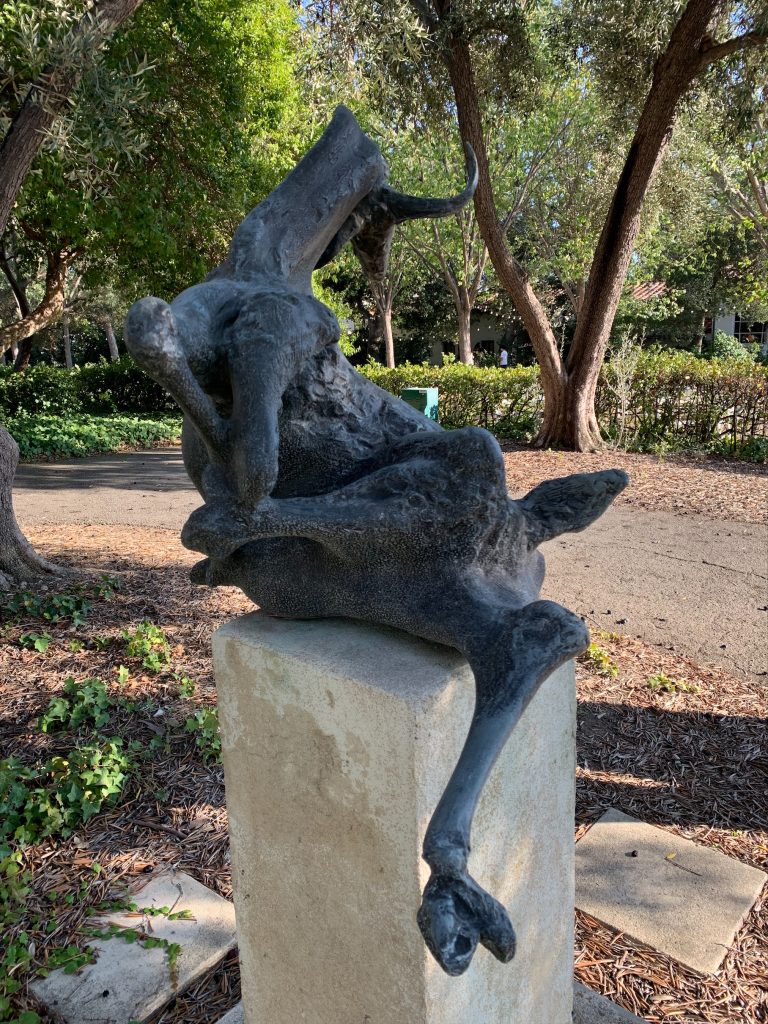AJ Jolish ‘25
Staff Writer
Between Elm Tree Lawn and the Humanities building, a bronze goat sits contorted in pain.
Kaia Stannard-Stockton ’25 walks by the sculpture, titled Bound Goat Thursday, every day. “It kind of freaks me out, and I’ve always wondered about the meaning behind it,” she said.
The plaque accompanying the sculpture lists the name of its creator, Jack Zajac, and that it was a gift from the Fine Arts Foundation and the National Foundation for the Arts in 1979. There is no information, however, on the meaning of the statue.
None of the art on Scripps’ campus comes with artist’s statements, but none of the other art seem to need one. Just feet away from Bound Goat Thursday is another bronze statue: Man and Nature, by Albert Stewart in 1965. The statue depicts an elongated male figure surrounded by leaflike geometric shapes and a tiny, roughly-hewn raccoon. Overall, it is pleasant to encounter as it surveys the Humanities courtyard serenely.
On the other hand, there is nothing serene about Bound Goat Thursday. From the spindly legs thrust out at crooked angles to the head thrown back in anguish, Bound Goat Thursday makes a dramatic statement. But what is that statement, exactly?
I spoke to Kirk Delman, the Interim Director of the Ruth Chandler Williamson Gallery, to learn more. “Zajac was very interested in the sacrificial animal as the subject of his sculpture,” Delman said. Along with Bound Goat Thursday, Zajac sculpted a Bound Goat Monday, Bound Goat Tuesday, and Bound Goat Wednesday, as well as the equally tortured Bound Goat (Santa Cruz Series XI) and Easter Goat I.
Delman hypothesized that this fixation on suffering was rooted in Zajac’s military service in World War II. “For many of those artists that lived through World War II, much of their work was significantly altered. When they came back, many of them were trying to find peace within themselves or looking for something optimistic and hopeful for the future. Others were, for the rest of their lives, either somewhat tormented and needed to express what they experienced,” Delman said.
I shared this newfound knowledge with a few fellow Scripps students. “I would never have guessed that Bound Goat Thursday might be about World War II. I always saw it as funny; I used to wish my friends a happy Bound Goat Thursday every week,” said Grace Gitau ’25.
Along with learning about what inspired Zajac’s art, I also learned that he had the surprising experience of being a cisgender male student at Scripps College. Zajac started as a student in Scripps summer classes, which did not employ Scripps’ usual restrictions at the time of being a female undergraduate student. Soon, Zajac became what ceramics professor Paul Soldner called a “special.” In the words of Kirk Delman, “specials” were “students who didn’t complete their college or graduate studies for a variety of personal reasons, who would pay 500 or 1000 dollars to use Scripps facilities and sharpen up their skills.”
Zajac would go on to win a Guggenheim Fellowship and the Rome Prize and become a professor at University of California, Santa Barbara.
Image Source: AJ Jolish ’25



